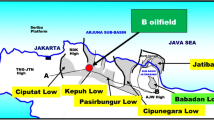Abstract
In this paper, a numerical model using three-dimensional finite difference code FLAC3D is proposed for analysing the stability of an oil well drilled in four formations. Normalized Yielded Zone Area (NYZA, i.e., the ratio of surrounding yielded cross-sectional area to initial area of well) has been determined for different mud pressures. In each formation, by interpolating of obtained NYZA equal to one, the optimized mud pressure was determined using MATLAB software. Practical data including geomechanical parameters along with drilling data from one of Iranian oilfields, Mansouri-54 well have been utilized in this analysis. In situ stress was determined using stress polygon method and conducting hydraulic fracturing data in the field. Analytical solution using the Mogi–Coulomb and the Hoek–Brown failure criteria has been carried out and results are compared with the presented model. The results demonstrated that the NYZA and Hoek–Brown criteria might underestimate and overestimate the drilling mud pressure, respectively, and should be used cautiously. In the inclined section of the well, plastic zone showed more extension in the lower part than upper part of the well because of the high stress concentration.







Similar content being viewed by others
References
Al-Ajmi A M and Zimmerman R W 2005a Relation between the Mogi and the Coulomb failure criteria. Int. J. Rock. Mech. Min. Sci. 42: 431–439
Al-Ajmi A M and Zimmerman R W 2005b Relationship between the parameters of the Mogi and Coulomb failure criterion. Int. J. Rock. Mech. Min. Sci. 42(3): 431–39
Alavi M 2004 Regional stratigraphy of the Zagorsk fold-thrust belt of Iran and its proforeland evolution. Am. J. Sci. 304: 1–20
Alavi M 1994 Tectonics of the Zagros orogenic belt of Iran: new data and interpretations. Tectonophysics 229: 211–238
Barton C A, Zoback M D and Burns K L 1988 In-situ stress orientation and magnitude at the Fenton geothermal site, New Mexico, determined from well breakouts. Geophys. Res. Lett. 15(5): 467–70
Bell J S 1996 In-situ stresses in sedimentary rocks (Part 1) Measurement techniques. Geoscience Canada 23(2): 85–100
Bell J S 2003 Practical methods for estimating in-situ stresses for borehole stability applications in sedimentary basins. J. Pet. Sci. Eng. 38: 111–119
Brown E T 1970 Strength of models of rock with intermittent joints. J. Soil Mech. Foundn. Div. ASCE 96, SM6, 1935–1949
Brown E T and Hoek E 1978 Trends in relationships between measured rock in situ stresses and depth. Int. J. Rock. Mech. Min. Sci. & Geomech. Abstr. 15: 211–215
Brudy M et al 1997 Estimation of the complete stress tensor to 8 km depth in the KTB scientific drill holes; implications for crustal strength. JGR102-8 18: 453–75
Detournay C and Chen X 2005 Factors governing mud filtration and impact on well stability: 40th U. S. Symp. Rock Mech. USRMS
Fjaer E et al 2008 Petroleum related rock mechanics. 2nd ed. UK, Elsevier
Garrouch A A and Ebrahim A S 2001 Assessment of the stability of inclined wells. Pet. Eng. Dep. Kuwait Univ. SPE 68861
Hoek E 1968 Brittle failure of rock. In Rock Mechanics in Engineering Practice. Stagg K G and Zienkiewicz O C (eds), 99–124
Hoek E and Brown E T 1980 Underground Excavations in Rock. London; Instn Min; Metall
Hoek E, Torres C C and Corkum B 2002 Hoek–Brown failure criterion. Proc. NARMS-TAC Conference, Toronto, 1: 267–273
ITASCA FLAC3D 2006 Student License. Itasca Consulting Group, Inc. USA
Mottiei H 1995 Geology of Iran; Petroleum Geology of Zagros. Geological Society of Iran Publication 37(2): 1009 P
National Iranian Oil Company (Southern branch), 2005 Geological studies office, Report of DSI measurements in Mansouri oil field, Ahvaz, Iran
Reynolds et al 2006 Constraining stress magnitudes using petroleum exploration data in the Cooper–Eromanga Basins. Australia Tectonophysics 415: 123–140
Rocscience Inc. 2004 Roc Data 3.0 User Guide
Salehi S and Hareland G 2010 Numerical simulations of well stability in under-balanced-drilling wells. J. Pet. Sci. Eng. S 0920-4105(10): 00078-1
Sheorey P R 1994 A theory for in situ stresses in Isotropic and transversely isotropic rock. Int. J. Rock. Mech. Min. Sci. & Geomech. Abstr. 31(1): 23–34
Terzaghi K and Richart F E 1952 Stresses in rock about cavities. Geotechnique 3: 57–90
Willson S M et al 1999 Drilling in South America: A well stability approach for complex geologic conditions. SPE 53940. In: Sixth LACPEC Conference. Caracas, Venezuela
Zoback M D et al 2003 Determination of stress orientation and magnitude in deep wells. Int. J. Rock. Mech. Min. Sci. 40: 1049–1076
Author information
Authors and Affiliations
Corresponding author
Rights and permissions
About this article
Cite this article
ELYASI, A., GOSHTASBI, K., SAEIDI, O. et al. Stress determination and geomechanical stability analysis of an oil well of Iran. Sadhana 39, 207–220 (2014). https://doi.org/10.1007/s12046-013-0224-3
Received:
Revised:
Accepted:
Published:
Issue Date:
DOI: https://doi.org/10.1007/s12046-013-0224-3




